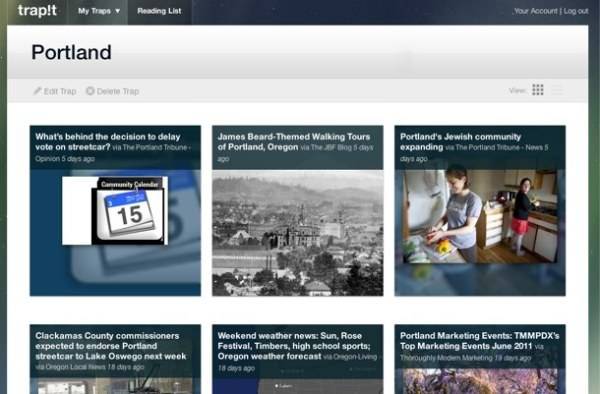How would you like to have a “cognitive prosthetic” that could “adapt to unexpected events” in situations of “intense information overload”…as a personal newsreader app online? That sounds pretty hot and it’s exactly what startup TrapIt was when it spun out of DARPA’s $200 million research project CALO (Cognitive Assistant That Learns and Organizes) more than a year ago.

TrapIt begins to open up its next-generation newsreader today (the first 500 people to visit this link can try it out for themselves) and I’ve been testing it this afternoon. My verdict so far? It’s attractive, the user experience is pretty good, it seems like its smarts could deliver some meaningful value with ongoing use – but like so many newsreading services trying to go mainstream, the quantity of news it delivers is just too small.
CALO is the same research project that birthed Siri, the voice controlled personal assistant acquired last year by Apple that’s widely expected to be a big part of the iPhone of the future. TrapIt has similarly big ambitions, but it’s in a very crowded field.
The service scours the web to identify possible sources of information, an average of 5,000 sources are indexed each day the company says, then it throws out 80% of what it finds in a quality control process that concludes with human editorial judgement. The service looks through updates from a total of fifty thousand sources daily.

How crowded is this market? There are scores and scores of news consumption apps launching all the time on the iPad alone. “We thought we’d differentiate ourselves” by offering a website first, TrapIt told me. It has truly come to that. Someone’s going to solve this problem, though, and deliver on the promise that RSS readers failed to bring to mainstream audiences. It could be TrapIt and all their information science.
Then it monitors those sources and finds just what it thinks you’ll like to read based on your implicit and explicit feedback. How good are the results? I’m not sure yet, but my initial testing indicates that so far the experience is ok. I’d like to see more stories delivered, but otherwise I think I like it so far. Will I go back to it daily for news on topics of interest to me? I’ll try it for a few days, but at this point I’m presuming that it’s not going to replace full-scale readers like
,
, Fever and
in my life. If a service is going to bring me 3 to 10 articles on each topic of interest to me – those are going to have to be some pretty incredible articles in order for me to consider it worth the trouble. (So far they aren’t that incredible.) Maybe TrapIt can do that with more training, we’ll see.
TrapIt says it uses a cocktail of algorithms to personalize, de-duplicate and deliver the key stories each day. The company says it’s working on accessibility today and will shift its focus to features better suited to power users next. But does one have to be a power user before objecting to an online news product that only delivered me 6 stories over 2 days on a topic as broad as “fine art”? It did better to find me 7 stories on the subject of Twitter today. But only 9 stories over the last 3 weeks on my hometown of Portland, Oregon?
These aren’t particularly fabulous stories, either. I asked the company how it determined both relevance and quality and the TrapIt team seemed to argue that relevance is the only thing that can really be determined – because one person’s low quality story is another person’s high quality story. Maybe. But the company said that at least one of its competitors delivered little more than “Google News keyword search in a tiled visual interface” – it’s not readily apparent to me how different all the technology behind TrapIt is from the same thing in the end, except that it delivers a more narrow stream of results. At first, at least though, they seem pretty arbitrary.
Perhaps my problem is that my interests are too obscure. Perhaps I shouldn’t use TrapIt to try to track interests like Ceramics, OPML (seriously, that’s just not fair) and Portland, Oregon. Maybe I should be using it to track news about vampires, robots, TV and GOP Presidential hopefuls (the recommended topics). Except I don’t want to do that, and I thought I was going to get personalized content.
I’ll keep trying TrapIt a little while longer, though. The user experience is pretty good, but for a few little bugs, and the problem space being tackled here is very interesting. Give it a shot and let me know what you think, readers.










